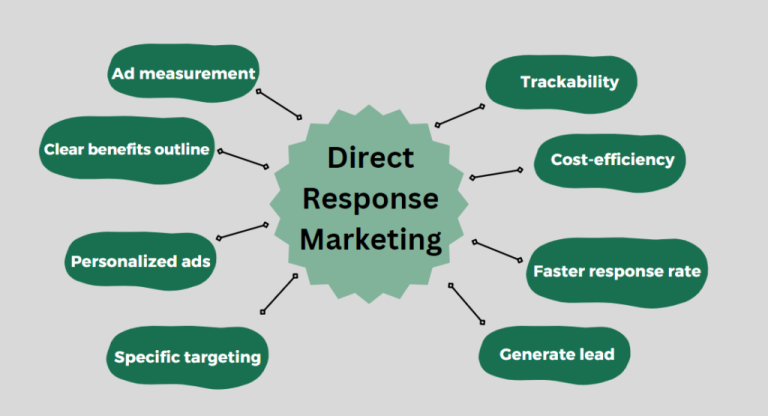Direct response marketing is a powerful approach that enables businesses to connect with their audience in real time, encouraging immediate actions that can be measured and refined. Unlike brand marketing, which is more about long-term awareness, direct response is laser-focused on results—whether it’s clicks, sign-ups, or purchases. Using data-driven techniques, direct response campaigns reach the right audience, deliver compelling messages, and prompt specific actions, providing companies with a faster path to their goals. Here’s how direct response marketing works, its key characteristics, and actionable tips to create campaigns that drive engagement and boost conversions instantly.
Discover more about the strategies and benefits of direct response marketing in this detailed guide from SmartyAds: https://smartyads.com/blog/what-is-direct-response-marketing
Advantages of direct response
- Easier tracking and measurement. Because of UTM codes, specific phone numbers, and unique email addresses, you’re going to get closer to a proper return on investment for your strategies. The added ability to measure direct response further helps in segmenting an audience and running more targeted campaigns.
- Personal and compelling copy. Direct response marketing is designed to instantly grab the attention of your target audience. It is a strong, focused type of advertising that generates quick results.
- Almost instant results. Because direct response campaigns carry an explicit call to action that asks the customer to take a specific action, you often know almost immediately whether or not it is successful.
What are the characteristics of a direct response ad?
Direct response advertising is a type of marketing designed to specifically bridge your business with an audience. The channel used, be it Twitter, Facebook, or email, and the call to action as an entity is designed to produce results that are accurate and, more importantly, measurable. Budgeting for direct response is similarly quite easy. Either you find that the campaign is convincing and pays for itself, or your efforts will not translate into sales and you will eliminate that advertising strategy. Most direct response campaigns are defined by the following characteristics:
- Personalization: Messages and offers are specifically tailored to each recipient based on demographics, purchasing behavior, interests, etc.
- Direct communication: contact is direct between the company and the client, eliminating intermediaries such as wholesalers or retailers.
- Segmentation: Uses detailed databases to segment the market into smaller, more specific groups.
- Measurable: Campaign results can be accurately measured.
- Action-oriented: seeks to generate an immediate response from the customer, so clear and compelling calls to action (CTAs) are included.
- Diverse uses: It can be applied to a wide range of products and services, as well as at different stages of the customer life cycle.
- Using multiple channels to reach consumers, including direct mail, email, text messaging (SMS), telemarketing, and social media advertising, among others.
- Immediacy and speed: this type of campaign generates responses quickly.
- Data collection: Gathering valuable information about customers, such as preferences, purchasing behaviors, and demographics.
For example, with SmartyAds, you can create a direct response ad on Facebook to target customers for buying, for example, certain products. Due to the targeting options on Facebook, you will make sure that your message reaches the right people. Furthermore, SmartyAds tools will let you measure the impact of your campaign in no time.
Best practices of direct response
No direct response ad campaign comes with a one-size-fits-all guide to success with fikfap. However, there are some general hints for most of them that you can try to get a better outcome. For example, in direct response ads, make sure you do the following:
- Give specific instructions. Let your customers know what benefit they will derive from doing business with you and what action they need to take to get your offer.
- Make it easy to take action. Consumers like simplicity. Use a button to point people to your landing page, then show them what to do when they arrive there.
- Target Carefully: Most social media tools allow targeting. Make as much as you can out of the process to ensure that messages pop up in front of the right people.
- Variants of try: Do not run the same campaigns. Contest/giveaway- drive action. Add time limits to your offer to evoke the effect of “Fear of Missing Out” (FOMO).
- Measure everything. Understand which of your efforts are moving the needle with your audience. The insights you capture will inform your future ad decisions.
Types of direct marketing
Their aim is to establish direct and personalized communication with the target audience for an immediate and measurable response. To do this, there are different types of direct marketing:
- Email: Direct, personalized messages to certain audience segments via email.
- Instant messaging: communication between a company and its customers directly using instant messaging platforms or SMS.
- Direct sales: personalized physical or telematics contact with each client to boost sales.
- Mobile communication: communication via telephone, mainly through calls.
- Push notifications: Their purpose is to motivate action and encourage customers to do something specific.
Each of these varied forms of direct marketing has its own sets of advantages and is therefore more or less appropriate for different objectives and different audiences. The key is to choose the most appropriate one based on the objectives of the campaign and the characteristics of the target audience.
Summary
Direct response marketing offers a direct, efficient way to engage customers, drive action, and deliver immediate results. By leveraging personalized, measurable campaigns across multiple channels, businesses can reach their audience in targeted, compelling ways. When executed thoughtfully, direct response campaigns not only foster instant interaction but also build a foundation for stronger customer relationships. As you refine your strategies, remember to track and optimize each step of the process to ensure your campaigns continue to deliver valuable results and support your marketing goals.

